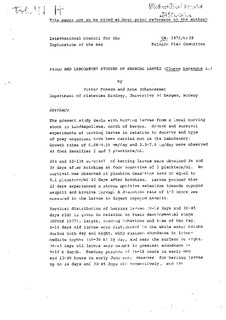| dc.contributor.author | Fossum, Petter | |
| dc.contributor.author | Johannessen, Arne | |
| dc.date.accessioned | 2011-09-07T09:15:16Z | |
| dc.date.available | 2011-09-07T09:15:16Z | |
| dc.date.issued | 1979 | |
| dc.identifier.citation | This report is not to be quoted without prior consultation with the General Secretary. | en_US |
| dc.identifier.uri | http://hdl.handle.net/11250/103515 | |
| dc.description.abstract | The present study deals with herring larvae from a local herring
stock in Lindåspollene, north of Bergen. Growth and survival
experiments of herring larvae in relation to density and type
of prey organisms have been carried out in the laboratory.
Growth rates of 0.08-0.19 mm/day and 2.3-7.6 ~g/day were observed
at food densities 1 and 3 plankters/ml.
20% and 10-13% survival of herring larvae were obtained 26 and
39 days after hatching at food densities of 3 plankters/ml. No
survival was observed at plankton densities less or equal to
0.1 plankters/ml 22 days after hatching. Larvae younger than
22 days experienced a strong positive selection towards copepod
nauplii and bivalve larvae. A digestion rate of 1/2-3 hours was
measured in the larvae to digest copepod nauplii.
Vertical distribution of herring larvae (0-14 days and 30-45
days old) is given in relation to their developmental stage
(DOYLE 1977), length, feeding behaviour and time of the day.
0-14 days old larvae were distributed in the whole water column
during both day and night, with maximum abundance in intermediate
depths (10-30 m) by day, and near the surface by night.
30-45 days old larvae were caught in greatest abundance in
5-15 m depth. Feeding periods of 16-18 hours in early May
and 13-20 hours in early June were observed for herring larvae
up to 14 days and 30-45 days old respectively, and 19% and 65% of the larvae were recorded with food in their guts
during the feeding period. In the laboratory 67% and 82% of
8 and 22 days old larvae were observed with gut contents after
a feeding period of 1 hour.
Laboratory experiments indicate that Bolinopsis infundibulum
and Sarsia tubulosa have a considerable predator potential for
newly hatched herring larvae. | en_US |
| dc.language.iso | eng | en_US |
| dc.publisher | ICES | en_US |
| dc.relation.ispartofseries | ICES CM Documents;1979/H:28 | |
| dc.title | Field and laboratory studies of herring larvae (Clupea harengus L.) | en_US |
| dc.type | Working paper | en_US |
| dc.subject.nsi | VDP::Mathematics and natural science: 400::Zoology and botany: 480::Marine biology: 497 | en_US |
| dc.subject.nsi | VDP::Agriculture and fishery disciplines: 900::Fisheries science: 920::Aquaculture: 922 | en_US |
| dc.source.pagenumber | 31 s. | en_US |
